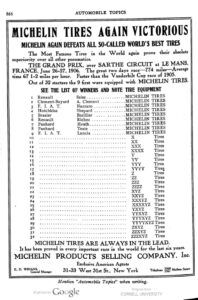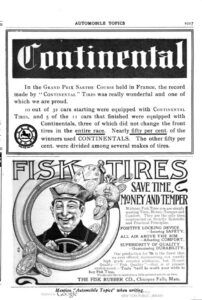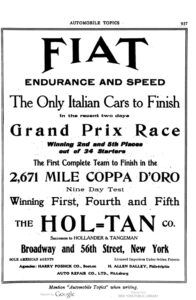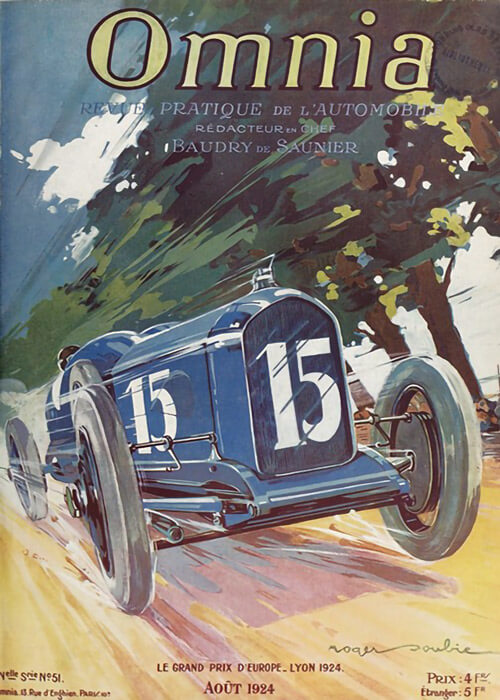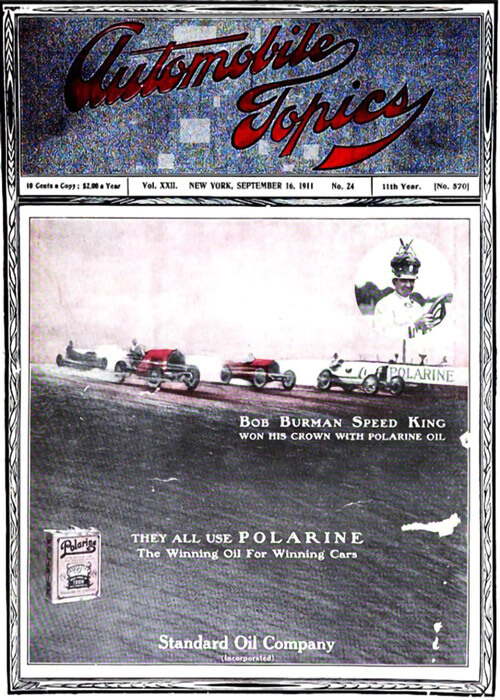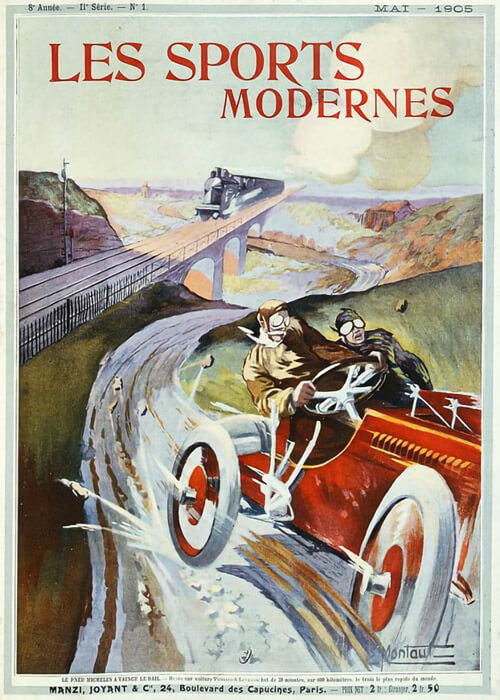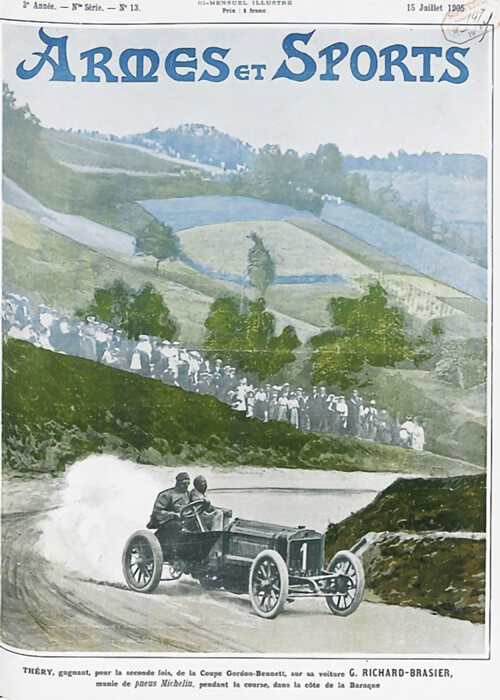The 1906 Grand Prix de l’Automobile Club de France was the first ever Grand Prix, being the successot to the Gordon Bennett Cup races. The Grand prix was run on the Sarthe circuit, a triangular form with several long stretches, resulting in high average speeds. It was run over two days in dry and very hot weather. Ferenc (Francois) Szisz on a light powered Renault was the winner.he won mainly because of the new demountable wheel rims, giving time advantage during pit stops for tire change.
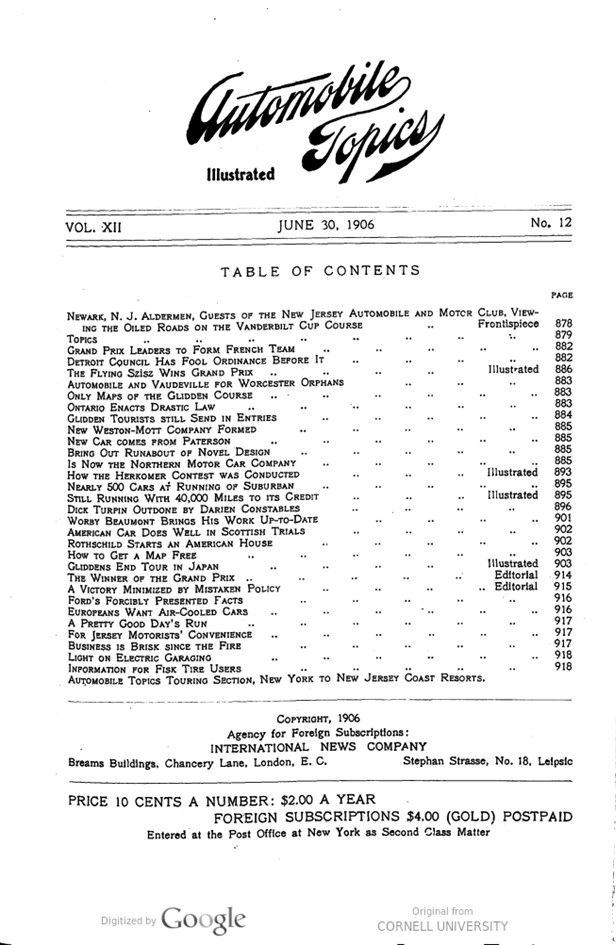

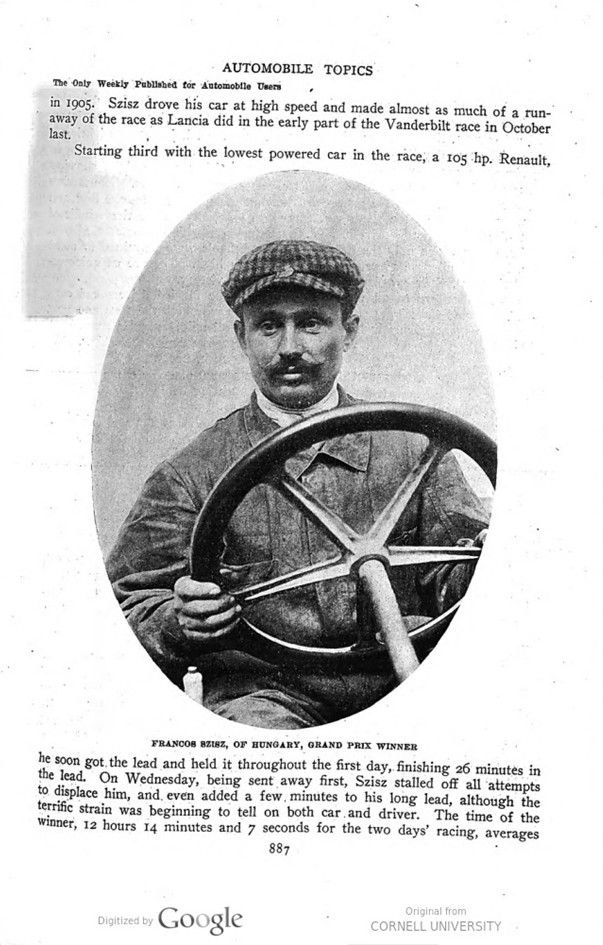

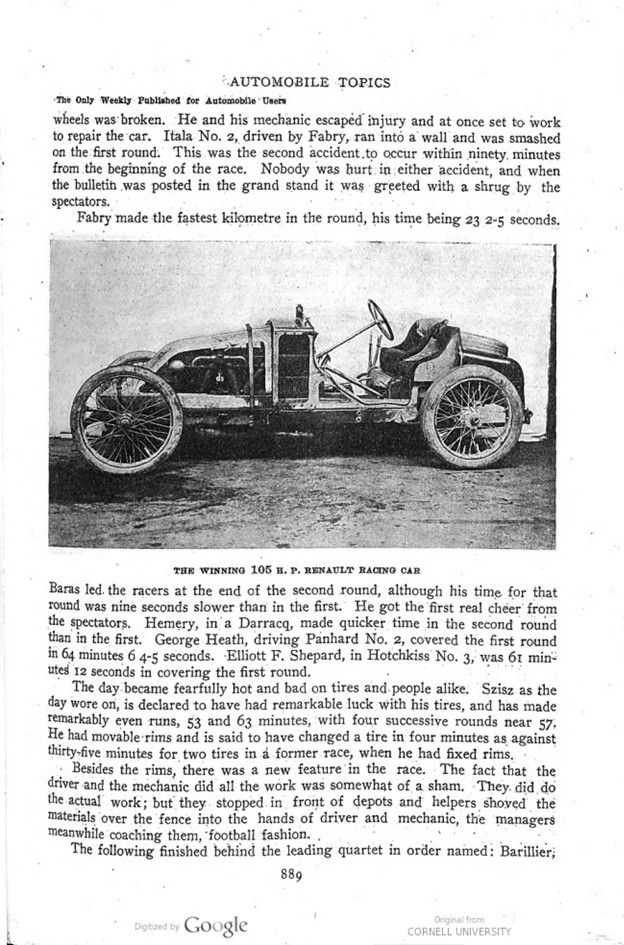
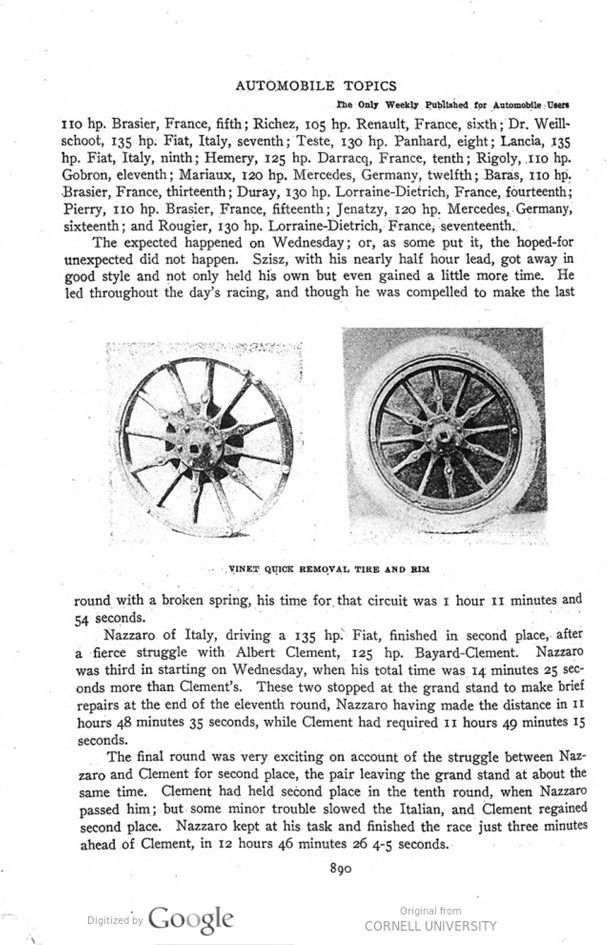
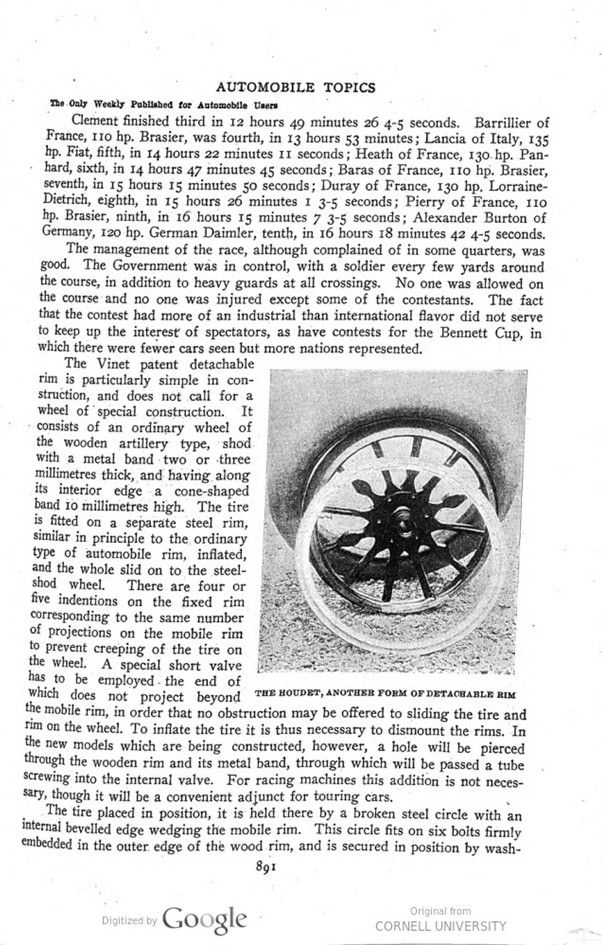
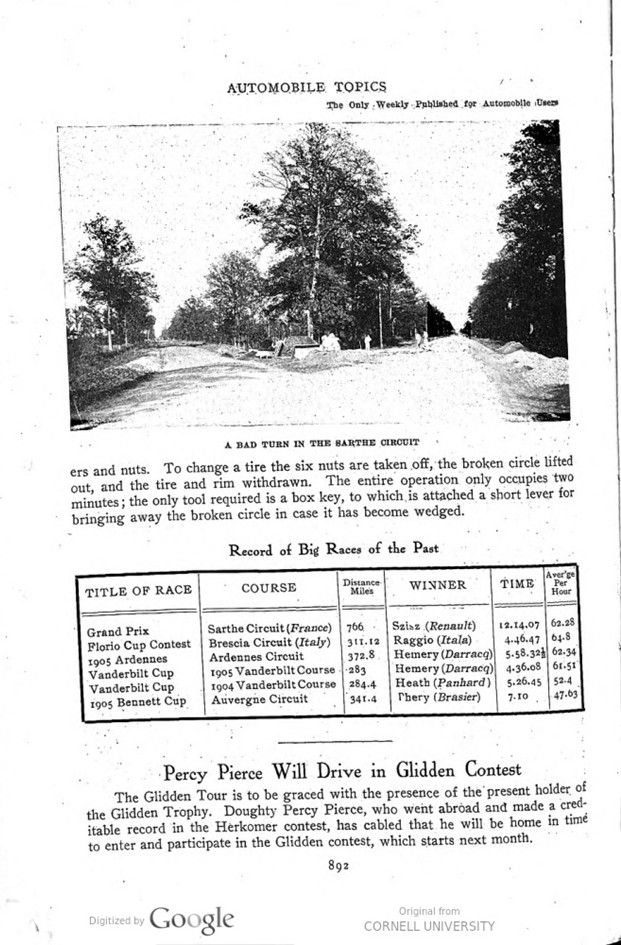
Text and jpegs by courtesy of hathitrust.org www.hathitrust.org, compiled by motorracinghistory.com
Automobile Topics, Vol. 12, No. 12, June 30, 1906, page 886-892
THE FLYING SZISZ WINS GRAND PRIX
Driving a French Car, the Hungarian Outspeeds a Field of 31 Starters-Averages 62.28 MIles per Hour.
Order of Finish DRIVER AND CAR TIME
1 Szisz, 105 hp. Renault 12.14.07
2 Nazzaro, 135 hp. Fiat 12.45.25
3 Clement, 125 hp. Clement-Bayard 12.49 46
4 Barrillier, 110 hp. Brasier 13.53
5 Lancia, 135 hp. Fiat 14.22.11
6 Heath, 130 hp. Panhard 14.47.45
7 Baras, 110 hp. Brasier 15.15.50
8 Duray, 130 hp. De Dietrich 15.26.01
9 Pierry. 110 hp. Brasier 16.15.07
10 Burton, 120 hp. German Daimler 16.18.42
Length of course, 1236 kilometers =766 miles.
Time of winner, 12 hours, 14 minutes, 7 seconds.
Average time of winner, 62.28 miles per hour.
IN a race that for brilliancy, dash and skill has never been surpassed, Francois Szisz, the Hungarian driver of a French car, the Renault, on Tuesday and Wednesday, won the first Grand Prix from a field of 31 starters by the big margin of 31 minutes and 18 seconds over his nearest competitor, Nazzaro, the Italian driver of a Fiat car, who won second place in last year’s Bennett race and who competed in the Vanderbilt Cup race in 1905. Szisz drove his car at high speed and made almost as much of a runaway of the race as Lancia did in the early part of the Vanderbilt race in October last.
Starting third with the lowest powered car in the race, a 105 hp. Renault, he soon got the lead and held it throughout the first day, finishing 26 minutes in the lead. On Wednesday, being sent away first, Szisz stalled off all attempts to displace him, and even added a few minutes to his long lead, although the terrific strain was beginning to tell on both car and driver. The time of the winner, 12 hours 14 minutes and 7 seconds for the two days‘ racing, averages 62½ miles per hour, and was considerably better than this on the first day.
The race was a memorable one from many points of view. As an international contest, the successor of the Bennett Cup race, it just escaped being a fizzle. The two days‘ innovation – or rather a return to the former practice in big European races – was a failure, the spectators tiring of the sight, showing that repeated circuits of a course are wearisome after a few hours. The tarring of the course kept down the dust somewhat but the glare, the intense heat and the wear and tear on the roads and cars and especially on the tires-inflicted great discomfort on the drivers, and, in conjunction with the new rule about repairs, under which only the driver and his mechanic were permitted to make them, knocked all predictions on the outcome sky high. The use of quick removal rims on Szisz’s car played a large part in his victory.
Most sensational of all was the downfall of the fancied drivers and cars. With Thery and Callois out the Brasier car, which won both the 1904 and 1905 Bennett races, was seriously handicapped, but by splendidly regular running all finished in the first nine. The much praised Darracqs failed lamentably, as did the German Daimlers. Lancia did well, finishing fifth, but was eclipsed by his companion, Nazzaro, who piloted the Fiat into second place. Of the first four drivers not one ranked better than 20 to I in the betting while Szisz, the winner, was a 40 to 1 shot.
Viewed as an international race, France had somewhat the best of it, but by no means as much as her predominance in starters should have given her. Of the 31 starters 23 were French cars and 5 Italian. Of the first 5 to finish 3 were French, 2 Italian; of the first 10 cars 7 were French, 3 foreign.
The race was run on what is termed the Sarthe circuit, a triangular-shaped course near the city of Le Mans. The long, straight stretches permitted high speed to be made, with the result that all former big races, with the exception of last year’s Brescia circuit, were eclipsed in point of speed. There were comparatively few casualties, none of them fatal.
Starting in third place on Tuesday, Szisz passed Gabriel on the first lap and Lancia on the third, and driving his 105 hp. Renault racer with rare skill finished the six laps in 5.45.30, nearly 26 minutes ahead of his nearest rival, Albert Clement (Clement-Bayard), who finished second in the 1904 Vanderbilt Cup Race. Clement, in turn, was 15 minutes ahead of Nazzaro, (Fiat) the third driver, while Elliot Shepard, the American, was fourth in a Hotchkiss.
The day was hot, even early in the morning, and the tar-covered road, stretching away and glistening in the sun as far as the eye could see, gave promise of playing havoc with tires-a promise that was fulfilled to the letter. Promptly at 6 o’clock Gabriel (De Dietrich) was sent away on his first lap, to be followed by the other thirty cars at 112 minute intervals. Up to 9 o’clock Gabriel had not been heard from at the grand stand. The second to start was Lancia, driving a Fiat. Lancia was first to complete the first round and the crowd at the finish greeted him warmly when he appeared, leading the racers. His time was 53 minutes 42 4-5 seconds for the lap. This time was beaten in the first round by Baras, driving a Brasier car, who covered the course in 52 minutes 25 3-5 seconds. Le Blon, driving a Hotchkiss car, was overturned at St. Calais and one of his wheels was broken. He and his mechanic escaped injury and at once set to work to repair the car. Itala No. 2, driven by Fabry, ran into a wall and was smashed on the first round. This was the second accident, to occur within ninety, minutes from the beginning of the race. Nobody was hurt in either accident, and when the bulletin was posted in the grand stand it was greeted with a shrug by the spectators.
Fabry made the fastest kilometre in the round, his time being 23 2-5 seconds. Baras led the racers at the end of the second round, although his time for that round was nine seconds slower than in the first. He got the first real cheer from the spectators. Hemery, in a Darracq, made quicker time in the second round than in the first. George Heath, driving Panhard No. 2, covered the first round in 64 minutes 6 4-5 seconds. Elliott F. Shepard, in Hotchkiss No. 3, was 61 minutes 12 seconds in covering the first round.
The day became fearfully hot and bad on tires and people alike. Szisz as the day wore on, is declared to have had remarkable luck with his tires, and has made remarkably even runs, 53 and 63 minutes, with four successive rounds near 57. He had movable rims and is said to have changed a tire in four minutes as against thirty-five minutes for two tires in a former race, when he had fixed rims.
Besides the rims, there was a new feature in the race. The fact that the driver and the mechanic did all the work was somewhat of a sham. They did do the actual work; but they stopped in front of depots and helpers shoved the materials over the fence into the hands of driver and mechanic, the managers meanwhile coaching them, football fashion.
The following finished behind the leading quartet in order named: Barillier, 110 hp. Brasier, France, fifth; Richez, 105 hp. Renault, France, sixth; Dr. Weill- schoot, 135 hp. Fiat, Italy, seventh; Teste, 130 hp. Panhard, eight; Lancia, 135 hp. Fiat, Italy, ninth; Hemery, 125 hp. Darracq, France, tenth; Rigoly, 110 hp. Gobron, eleventh; Mariaux, 120 hp. Mercedes, Germany, twelfth; Baras, 110 hp. Brasier, France, thirteenth; Duray, 130 hp. Lorraine-Dietrich, France, fourteenth; Pierry, 110 hp. Brasier, France, fifteenth; Jenatzy, 120 hp. Mercedes, Germany, sixteenth; and Rougier, 130 hp. Lorraine-Dietrich, France, seventeenth.
The expected happened on Wednesday; or, as some put it, the hoped-for unexpected did not happen. Szisz, with his nearly half hour lead, got away in good style and not only held his own but even gained a little more time. He led throughout the day’s racing, and though he was compelled to make the last round with a broken spring, his time for that circuit was I hour 11 minutes and 54 seconds.
Nazzaro of Italy, driving a 135 hp. Fiat, finished in second place, after a fierce struggle with Albert Clement, 125 hp. Bayard-Clement. Nazzaro was third in starting on Wednesday, when his total time was 14 minutes 25 seconds more than Clement’s. These two stopped at the grand stand to make brief repairs at the end of the eleventh round, Nazzaro having made the distance in II hours 48 minutes 35 seconds, while Clement had required 11 hours 49 minutes 15 seconds.
The final round was very exciting on account of the struggle between Nazzaro and Clement for second place, the pair leaving the grand stand at about the same time. Clement had held second place in the tenth round, when Nazzaro passed him; but some minor trouble slowed the Italian, and Clement regained second place. Nazzaro kept at his task and finished the race just three minutes ahead of Clement, in 12 hours 46 minutes 26 4-5 seconds.
Clement finished third in 12 hours 49 minutes 26 4-5 seconds. Barrillier of France, 110 hp. Brasier, was fourth, in 13 hours 53 minutes; Lancia of Italy, 135 hp. Fiat, fifth, in 14 hours 22 minutes II seconds; Heath of France, 130. hp. Pan- hard, sixth, in 14 hours 47 minutes 45 seconds; Baras of France, 110 hp. Brasier, seventh, in 15 hours 15 minutes 50 seconds; Duray of France, 130 hp. Lorraine-Dietrich, eighth, in 15 hours 26 minutes 1 3-5 seconds; Pierry of France, 110 hp. Brasier, ninth, in 16 hours 15 minutes 7 3-5 seconds; Alexander Burton of Germany, 120 hp. German Daimler, tenth, in 16 hours 18 minutes 42 4-5 seconds.
The management of the race, although complained of in some quarters, was good. The Government was in control, with a soldier every few yards around the course, in addition to heavy guards at all crossings. No one was allowed on the course and no one was injured except some of the contestants. The fact that the contest had more of an industrial than international flavor did not serve to keep up the interest of spectators, as have contests for the Bennett Cup, in which there were fewer cars seen but more nations represented.
The Vinet patent detachable rim is particularly simple in construction and does not call for a wheel of special construction. It consists of an ordinary wheel of the wooden artillery type, shod with a metal band two or three millimetres thick, and having along its interior edge a cone-shaped band 10 millimetres high. The tire is fitted on a separate steel rim, similar in principle to the ordinary type of automobile rim, inflated, and the whole slid on to the steel- shod wheel. There are four or five indentions on the fixed rim corresponding to the same number of projections on the mobile rim to prevent creeping of the tire on the wheel. A special short valve has to be employed the end of which does not project beyond the mobile rim, in order that no obstruction may be offered to sliding the tire and rim on the wheel. To inflate the tire it is thus necessary to dismount the rims. In the new models which are being constructed, however, a hole will be pierced through the wooden rim and its metal band, through which will be passed a tube screwing into the internal valve. For racing machines this addition is not necessary, though it will be a convenient adjunct for touring cars.
The tire placed in position, it is held there by a broken steel circle with an internal bevelled edge wedging the mobile rim. This circle fits on six bolts firmly embedded in the outer edge of the wood rim, and is secured in position by washers and nuts. To change a tire the six nuts are taken off, the broken circle lifted out, and the tire and rim withdrawn. The entire operation only occupies two minutes; the only tool required is a box key, to which is attached a short lever for bringing away the broken circle in case it has become wedged.
Record of Big Races of the Past
TITLE OF RACE COURSE Distance WINNER TIME Average
Mile’s Per Hour
Grand Prix Sarthe Circuit (France) 766 Szisz (Renault) 12.14.07 62.28
Florio Cup Contest Brescia Circuit (Italy) 311.12 Raggio (Itala) 4.46.47 64.8
1905 Ardennes Ardennes Circuit 372.8. Hemery (Darracq) 5.58.32 62.34
Vanderbilt Cup 1905 Vanderbilt Course 283 Hemery (Darracq) 4.36.08 61.51
Vanderbilt Cup 1904 Vanderbilt Course 284.4 Heath (Panhard) 5.26.45 52.4
1905 Bennett Cup Auvergne Circuit 341.4 Thery (Brasier) 7.10 47.63
Photo captions, page 886 – 892
FRANCOIS SZISZ, OF HUNGARY, GRAND PRIX WINNER
THE WINNING 105 H. P. RENAULT RACING CAR
VINET QUICK REMOVAL TIRE AND RIM
THE HOUDET, ANOTHER FORM OF DETACHABLE RIM A BAD TURN IN THE SARTHE CIRCUIT
—————
Automobile Topics Illustrated – A WEEKLY JOURNAL DEVOTED TO THE INTERESTS OF AMERICAN AUTOMOBILISTS.
VOL. XII No. 12 – NEW YORK, JUNE 30, 1906 Page 914-915
The Winner of the Grand Prix
With that so-called luck, which in this case is but another name for merit and management, France has won the first Grand Prix, just as she did the first Bennett Cup race, and, before that, the first regularly organized big road race. Italy is compelled to content herself with second place, a bitter disappointment in one way, a splendid showing in another. A second Italian car finished in the first four and gained fresh laurels for the youngster among automobile-producing nations. Germany, the sole remaining country to take part in the contest, was entirely out of the running.
The race thus results in a distinct victory for light, moderately-powered racing cars. The winning Renault was the lowest-powered car of the thirty-one which started – excepting of course the other two Renaults, all of them being rated at 105 hp. As was the case last year, therefore and in a majority of the great races of the past, it has been demonstrated conclusively that enormous horse power is not absolutely essential in a winning car. Nor is heavy weight, for the successful car was 15 kilograms inside the weight limit of 1,000 kilograms. This margin was probably caused by the substitution of wire for artillery wheels, which was one of the surprising features of the cars, viewed from a constructional standpoint. Much more novel than this change, however, was the fitting of quick removal wheels. By means of these a new tire could be substituted for a worn or punctured one in a marvelously short time and without requiring the tire to be inflated. The day being hot and trying on tires, this feature alone gave Szisz a decided advantage, although the number of his competitors who employed similar devices lessened this advantage very much.
A third innovation was the rule that drivers and their machines should make all repairs. This introduced a new element into the contest and was undoubtedly instrumental in delaying some cars until their chances of winning were entirely gone. Heretofore there was no limit to the number of helpers, and troubles of a really serious nature were undoubtedly put to rights without great loss of time.
